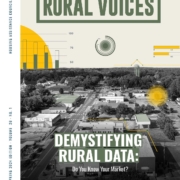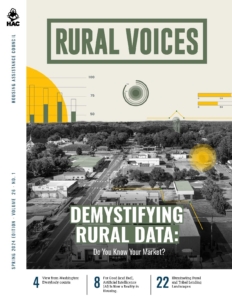HAC News Formats. pdf
February 1, 2018
Vol. 47, No. 3
February is African American History Month • Housing not included in State of the Union address • FY19 budget to be released this month • Latest continuing resolution ends February 8 • New Opportunity Zones program created by Tax Cuts and Jobs Act • Carson pledges to increase resources to rural America • IRS urges hurricane survivors to consider EITC • HUD considers changes to manufactured housing rules • RD multifamily housing financial reporting requirements clarified • RD offers guidance on using design/build and construction management proposals • Census Bureau not updating questions on race and ethnicity • HUD invites comments on new reporting system for IHBG recipients • House passes bill to exempt more lenders from HMDA • Gil Gonzalez named RD Chief of Staff • Native American Creative Placemaking published by HAC • Native CDFIs have high demand, need more resources, says survey • HAC releases report on USDA rural housing program activity in FY17 • Webinars offered on financing Farm Labor Housing with USDA Section 514/516 funding
HAC News Formats. >
February 1, 2018
Vol. 47, No. 3
February is African American History Month.
Housing not included in State of the Union address.
In his speech on January 30, President Trump mentioned a $1.5 billion infrastructure plan, but did not list housing among items that would be covered. HUD Secretary Ben Carson has said in the past that the Administration’s infrastructure proposal will include housing (see HAC News, 4/13/17).
FY19 budget to be released this month.
The Administration will release its proposed budget for FY19 (which begins October 1, 2018) on February 12 at the earliest, but it is expected to be a “skinny” budget without much detail, like the early budget proposal released in March 2017. HAC will post information online when the budget is available.
Latest continuing resolution ends February 8.
FY17 funding levels are continued through February 8 under the most recent in this year’s series of continuing resolutions. Congress and the Administration continue to seek agreement on raising the Budget Control Act’s funding caps and on spending levels for FY18, as well as numerous other issues.
New Opportunity Zones program created by Tax Cuts and Jobs Act.
The new tax legislation offers private investors an opportunity to defer taxes on capital gains by investing those gains in Opportunity Funds, which will finance a variety of investments, potentially including housing, in Opportunity Zones. Governors will identify Opportunity Zones in their states from among census tracts that meet the New Markets Tax Credit program’s definition of low-income communities, and may include some adjacent tracts. The program will begin after the Treasury Department develops regulations, although by March 21 governors must submit their Opportunity Zone designations or request a 30-day extension.
Carson pledges to increase resources to rural America.
Wisconsin Public Radio reports that at an appearance in the state in January, HUD Secretary Ben Carson said he is creating a task force on rural poverty, as well as reviewing HUD homelessness assistance programs to increase aid to rural areas. HUD is not listed among the members of the Task Force on Agriculture and Rural Prosperity, which recently released its report. HUD also recently withdrew the proposed rule for the Rural Housing Stability program, which would have helped address rural homelessness.
IRS urges hurricane survivors to consider EITC.
Workers with incomes under $53,930 in 2017 may be eligible for the Earned Income Tax Credit. Survivors of Hurricanes Harvey, Irma, and Maria can use a special computation method.
HUD considers changes to manufactured housing rules.
As it seeks to reduce regulatory costs and burdens, HUD requests comments by February 26 on its manufactured housing regulations. Contact Ariel Pereira, HUD, 202-402-5138.
RD multifamily housing financial reporting requirements clarified.
An Unnumbered Letter dated January 24, 2018, clarifies requirements – optional for FY18 and mandatory for FY19 – for owners of Section 514/516 and Section 515 properties. For more information, contact an RD State Office.
RD offers guidance on using design/build and construction management proposals.
Administrative Notice 4851, dated January 24, 2018, advises RD staff on obtaining National Office approval of such proposals for Section 514/516 farmworker housing or Section 515 rental housing projects. For more information, contact an RD State Office.
Census Bureau not updating questions on race and ethnicity.
The Bureau has announced that the 2020 Census will continue to use two separate questions to identify race and ethnicity. This decision overrules a Census Bureau recommendation last year based on research showing that minorities, who are historically undercounted in the decennial Census, are more likely to respond to a single combined question, reports the Coalition on Human Needs.
HUD invites comments on new reporting system for IHBG recipients.
Tribal leaders and Indian housing officials are asked for input on a new online system that will be implemented May 1. For more information, contact Frederick Griefer, HUD.
House passes bill to exempt more lenders from HMDA.
Home Mortgage Disclosure Act regulations previously required all lenders with assets above a certain level to report on their lending activity; now, under new HMDA rules that took effect on January 1, 2018, reporting is required if an institution originates over 25 mortgages, regardless of its asset size. On January 18 the House passed H.R. 2954, the Home Mortgage Disclosure Adjustment Act, which would raise the exemption threshold to 500 mortgages. The Senate has not voted on S. 1310, its version of the bill.
Gil Gonzalez named RD Chief of Staff.
Gonzalez served in USDA Rural Development from 2001 to 2005.
Native American Creative Placemaking published by HAC.
The report presents some established Native American creative placemaking efforts, offers an interactive map of Native American creative placemaking projects, and lists funding sources.
Native CDFIs have high demand, need more resources, says survey.
Findings from the 2017 Native CDFI Survey: Industry Opportunities and Limitationsreports on a survey by the Federal Reserve System’s Center for Indian Country Development, designed to show NCDFIs’ resource base, scope of work and geography, and challenges. The study found NCDFIs are ready to deploy more funds but face challenges including funding availability and other resource gaps.
HAC releases report on USDA rural housing program activity in FY17.
The publication provides data for each program and for each state or territory. In FY 2017, USDA obligated 149,860 loans, loan guarantees, and grants, as well as 308,060 annual units of tenant assistance. The agency guaranteed over 137,000 Section 502 mortgages and issued over 7,100 Section 502 direct loans. About 38% of the latter went to borrowers with very low incomes. Multifamily Housing Preservation and Revitalization obligations dropped from 2016 to 2017, probably at least in part because some MPR funding was transferred to the Section 542 voucher program, which grows every year.
Webinars offered on financing Farm Labor Housing with USDA Section 514/516 funding.
Final Application Processing and Closing will be February 7, followed by Construction and Lease-up on February 24. Registration is free. Preparing the Pre-application was held January 24 and is now archived online. The sessions are sponsored by Tierra del Sol Housing and the Community Resources and Housing Development Corporation, and hosted by HAC. For more information, contact Shonterria Charleston, HAC, 404-892-4824.
NEED CAPITAL FOR YOUR AFFORDABLE HOUSING PROJECT?
HAC’s loan funds provide low interest rate loans to support single- and multifamily affordable housing projects for low-income rural residents throughout the U.S. and territories. Capital is available for all types of affordable and mixed-income housing projects, including preservation, farmworker, senior, and veteran housing. HAC loan funds can be used for pre-development, site acquisition, site development, and construction/rehabilitation. Contact HAC’s loan fund staff at hacloanfund@ruralhome.org, 202-842-8600.
Please note: HAC is not able to offer loans to individuals or families. Borrowers must be nonprofit or for-profit organizations or government entities (including tribes).


